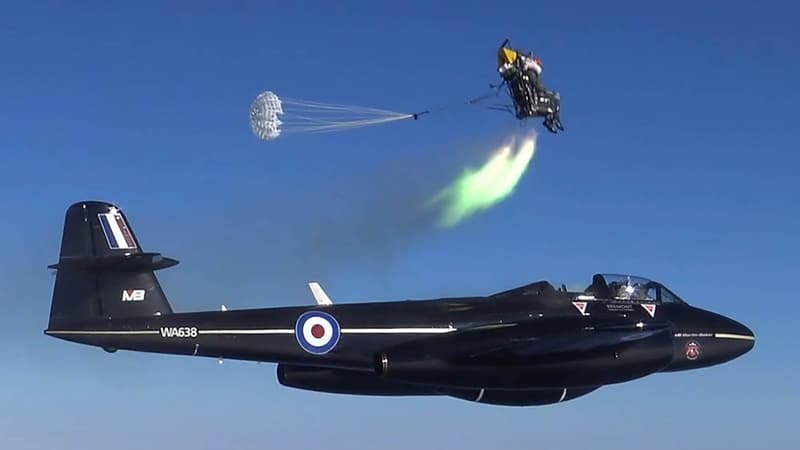Do you know the “expelled club”? Also called the “Ejection Tie Club”, it is a discreet and closed association of fighter pilots. However, entering is very simple. Well almost. You “simply” must have saved your life by pulling the ejection seat handle of your sinking plane in time. It is not given to everyone and no one rushes to become a member.
The signs of recognition of the members: a pin, a patch and the tie with red triangles pointing downwards, logo placed in the cockpit to warn of the danger related to the ejection seat. On the occasion of an evening organized on Thursday on the sidelines of the Bourget air show, five pilots recently admitted to the club were seen wearing the famous tie around their necks.
five second parachute
Among the recipients, Captain Julien (the French army prohibits the disclosure of last names), who was ejected from his Mirage 2000-5 “30 meters above the ground, just above the trees.” It was November 3, 2022. He was about to land at the Luxeuil (Haut-Saone) base when an electrical fire broke out when he was only 300 meters above sea level.
“The warning lights came on like a Christmas tree and then went off,” he says. With no more power to the motor, he steers the device into a wooded area, then pulls the yellow and black handle activating the eject.
Once the handle is pulled, it takes half a second for the seat to come out of the cockpit, and then two seconds for the parachute to deploy.
Captain Julien had to spend five seconds “sailing” (parachute, editor’s note), before hitting the ground, sustaining no damage. Six days later, he was flying again. A little later, two other ties share his experience:
7697 expelled so far
Since the world’s first in-flight ejection in 1946, Britain’s Martin Baker has kept his tally up: 7,697 ejected to date, including 718 for French-designed aircraft produced at Argenteuil by the Safran-Martin Baker (SMB) joint venture ). company.
Compared to the American Collins, Martin Baker equips 70% of the combat aircraft produced in the Western world (Eurofighter, Rafale, Gripen or even F-35). The Russians have their Zvedza seat and the Chinese theirs, “which look strikingly like the Martin Baker seats,” according to Roberto Visigalli, SMB’s program director.
There are more accidents in training than in combat, particularly due to “volatile collisions”, birds being swallowed by the engine. As for Max Moutoussamy, present in his tie on Thursday night, and thrown out of his Jaguar in 1991. Suddenly, “I have this smell of roast chicken in the cabin, (…) I tell myself no It’s a good sign,” he said on a podcast
20G acceleration
The seats have also evolved over time. “Before, we were satisfied with saving a life, now we try to get the pilot to fly the next day,” explains Yohann Fleury, SMB’s head of support and training.
The first generations only allowed an ejection once the plane had reached a certain speed and altitude. They can now be activated when the hunter is standing on the ground.
And where before the pilot had to support an acceleration of 20G – that is, 20 times the weight of the body – when the seat was propelled out of the cockpit, the latest MK16 seat allows it to be limited to 14G and to adapt the power of its engine -rocket. according to the weight of the pilot.
For Aimé Marion, tied after his ejection from the Mirage III “on December 16, 1968”, all this technology did not exist. He was forced to eject “in less than four seconds” when he realized he could not avoid a collision with a plane that had no business at the Colmar airstrip where he was to land. “Below the minimum survival height” at the time, he says. “I pulled the handle, I saw the ground and I did a lot of damage when I got there.” Wounded, but alive.
Source: BFM TV


